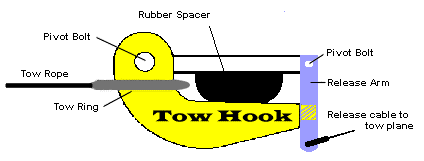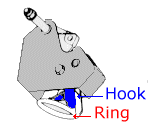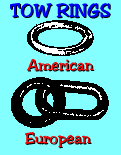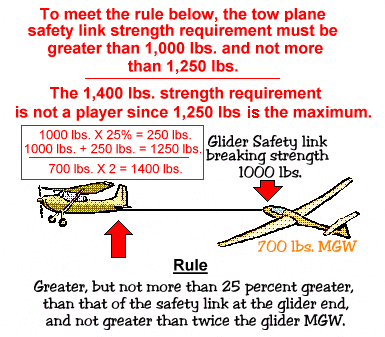Tow Hook Assembly Inspection & Operational Check
American Type Tow Hook
1. Visually inspect the tow hook and release arm for damage, cracks, deformation, and freedom of movement on pivot bolts.
2. Visually check tow hook to ensure the tow hook properly engages the release arm, inspect the rubber spacer for general condition, and check the condition of the release cable.
3. Check to see the manual release lever in the cockpit is not rubbing against the aircraft seat or any obstruction in the cockpit, check the security of the release handle assembly and the cable attachment.

4. Perform an operational check.
-
- Attach tow line to tow hook and apply tension on the line in direction of tow.
- With tension on tow line, have another person pull the release control in the tow plane cockpit and check for proper release of the tow line.
- If tow line does not properly release, restrict the tow plane from towing duties until repairs can be made.
- Reattach the tow line and apply a moderate tug in the direction of tow.
- Inspect the release assembly to ensure it has remained completely closed.
- If the release assembly has opened, even partially, Restrict the tow plane from towing duties and repair the tow assembly.
5. Insure that tow hook moves freely on pivot bolt and the pivot hole is not elongated.
European Type Tow Hook (TOST)
This release mechanism should not be repaired by anyone other than the TOST factory. Perform a functional check as follows:
1. The release hook should open completely (the release hooks should touch the ring) when the cockpit release is pulled to its fullest extent.

2. Check to see the manual release lever in the cockpit is not rubbing against the aircraft seat or any obstruction in the cockpit, check the security of the release handle assembly and the cable attachment.
3. When the cockpit manual release lever is released the tow hook should return to the fully closed position.
4. Perform an operational check.
-
- Attach tow line to tow hook and apply tension on the line in direction of tow.
- With tension on tow line, have another person pull the release control in the tow plane cockpit and check for proper release of the tow line.
- If tow line does not release properly. Restrict the tow plane from towing duties until repairs can be made.
- Reattach the tow line and apply a moderate tug in the direction of tow.
- Inspect the release assembly to ensure it has remained completely closed.
- If the release assembly has opened, even partially, restrict the tow plane from towing duties and repair the tow assembly.
5. Physically check the tow hook is free of dirt.
6. Ensure the tow plane end of the tow rope is fitted with a TOST tow ring.
Tow Ring Inspection

Ensure the tow line is configured for the proper type of hitch. While a Schweizer tow ring will not fit into a TOST hitch, a TOST tow ring can be placed on a Schweizer type hitch, with the great possibility of the TOST tow ring becoming stuck in the hitch mechanism making tow rope release impossible.
Tow Rope Inspection
Although the pilot of the glider is primarily responsible for selection and inspection of the proper towline, it is also the duty of the tow pilot to confirm that the towline selected meets the requirements of the Federal Aviation Regulations and is acceptable for use. Inspect the towline as follows:
- Check the entire length of the towline for abrasions, security of splices, and general condition.
- Ensure towline strength is appropriate for the glider/s being towed.
Typical Rope Strengths in Pounds
| Diameter | Hollow Braid | Polypropylene | Polypropylene | ||
|---|---|---|---|---|---|
| Nylon | Dacron | Polyethylene | Monofilament | Multifilament | |
| 3/16″ | 960 | 720 | 700 | 800 | 870 |
| 1/4″ | 1,500 | 1,150 | 1,200 | 1,300 | 1,200 |
| 5/6″ | 2,400 | 1,750 | 1,750 | 1,900 | 2,050 |
Towrope Strength Requirements (FAR 91.309)
-
- Minimum Strength = 80 percent of the glider maximum certificated operating weight
- Maximum Strength = twice the maximum certificated operating weight
Note: Maximum certificated operating weight can be found in the glider POH and may be the Maximum certificated gross weight at takeoff.
If the towrope has a breaking strength more than twice the maximum certificated operating weight of the glider being towed, a safety link has to be installed at the point of attachment of the glider and the tow plane with the following breaking strength requirements.
Safety Link (Weak Link) Requirements
Safety link (Weak Link) at the glider end:
- Minimum Strength = 80 percent of the glider maximum certificated operating weight
- Maximum Strength = twice the maximum certificated operating weight
Safety link (Weak Link) at the tow plane end:
- Strength Requirements = Greater, but not more than 25% greater than that of the safety link on the glider end, and not more than twice the maximum certificated operating weight of the glider



